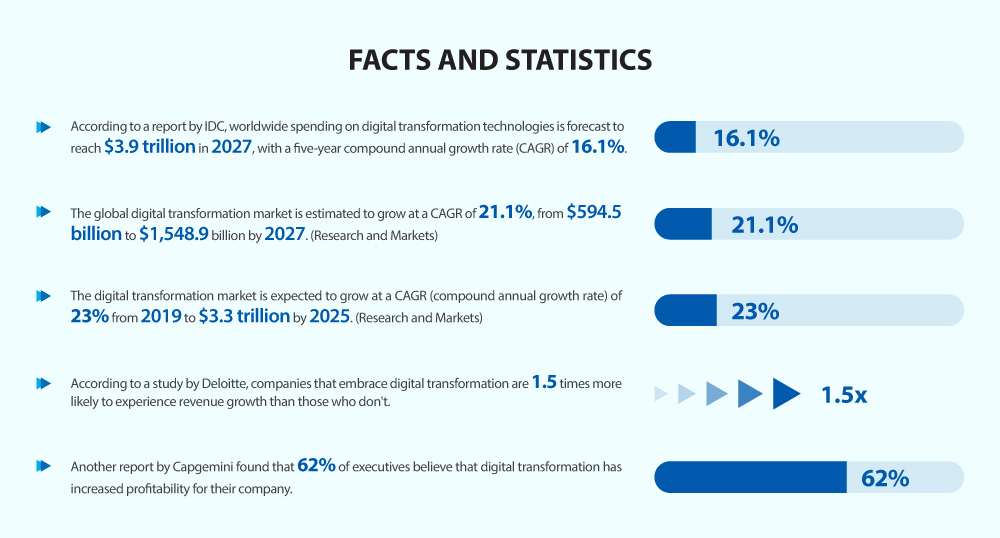A Beginner’s Guide to Digital Transformation
Feb 23, 2024 | Upasna Kesarwani
In today's fast-paced and ever-evolving business landscape, digital transformation has become more than just a buzzword – it's a necessity for survival and growth. But what exactly is digital transformation, and how can beginners navigate this complex terrain? In this comprehensive guide, we'll explore the fundamentals of digital transformation, backed by facts and statistics, to help you embark on this transformative journey with confidence.
Understanding Digital Transformation
Digital transformation is all about the use of digital technologies across all facets of a business, changing how it operates and delivers value to customers. It involves not just adopting new technologies but also reimagining the business's operations, culture, and customer service approach to remain competitive in an increasingly digital-first world.
Why Digital Transformation Matters
The digital revolution has reshaped industries and disrupted traditional business models. Here are some compelling reasons why digital transformation is essential:
1. Competitive Advantage: Organizations that embrace digital transformation gain a competitive edge by improving efficiency, innovation, and agility. According to a report by MIT, digitally mature companies are 26% more profitable than their less mature counterparts.
2. Customer Expectations: In today's digital age, consumers expect seamless, personalized experiences across all touchpoints. Failure to meet these expectations can result in customer churn and a loss of market share. Research by Gartner predicts that by 2025, 80% of traditional businesses will initiate a digital transformation effort to enhance the customer experience and improve operational efficiency.
Gartner Hype Cycle for Customer Service and Support Technologies, 2023
Source: Gartner (August 2023)
3. Data-Driven Insights: Digital transformation enables businesses to harness the power of data analytics to make informed decisions, identify trends, and anticipate customer needs. According to IDC, global spending on big data and business analytics reached $189.1 billion in 2019 and will maintain a steady pace, with a compound annual growth rate (CAGR) of approximately 12% from 2020 to 2024.
4. Adaptability: Digital transformation equips organizations with the flexibility to adapt to rapidly changing market conditions and technological advancements. This adaptability is crucial for staying relevant and future-proofing the business.
Case Studies on Digital Transformation
Here are three case studies that illustrate different aspects of digital transformation for beginners:
1. Netflix:
- Background: Netflix started as a DVD rental service but transformed into a global streaming platform.
- Digital Transformation Initiative: Netflix embraced digital transformation by shifting from physical media distribution to online streaming. They invested heavily in building a robust digital infrastructure, including scalable cloud computing services.
- Results: Today, Netflix boasts millions of subscribers worldwide and is a dominant force in the entertainment industry. Their digital-first approach revolutionized how people consume content, showcasing the power of digital transformation to disrupt traditional business models.
2. McDonald's:
- Background: McDonald's is a multinational fast-food chain known for its burgers and fries.
- Digital Transformation Initiative: McDonald's embarked on a digital transformation journey to enhance the customer experience and streamline operations. They introduced self-service kiosks, mobile ordering apps, and digital menu boards.
- Results: The implementation of digital technologies improved order accuracy, reduced wait times, and allowed for personalized marketing initiatives. McDonald's digital transformation not only boosted customer satisfaction but also increased operational efficiency and revenue.
3. GE (General Electric):
- Background: GE is a multinational conglomerate operating in various industries, including aviation, healthcare, and energy.
- Digital Transformation Initiative: GE embraced digital transformation by integrating IoT (Internet of Things) sensors into their industrial equipment. These sensors collect data to enable predictive maintenance, optimize performance, and reduce downtime.
- Results: By leveraging IoT and data analytics, GE transformed their traditional manufacturing processes into smart, connected systems. This digital transformation led to cost savings, improved equipment reliability, and new revenue streams through value-added services like predictive maintenance contracts.
These case studies demonstrate how companies in different industries have successfully transformed to achieve growth, to be more innovative, and to work more efficiently. They're helpful examples for beginners who want to see how digital transformation can be useful in real world.

Source: https://research.aimultiple.com/digital-transformation-stats/
Key Components of Digital Transformation
Digital transformation encompasses various elements, each playing a vital role in driving organizational change:
1. Technology Integration: Adopting cutting-edge technologies such as cloud computing, artificial intelligence (AI), the Internet of Things (IoT), and blockchain forms the foundation of digital transformation. For instance, 83% of organizations cite the cloud as a crucial component of their digital transformation strategy, according to a survey by LogicMonitor.
2. Cultural Shift: Successful digital transformation requires a cultural shift towards innovation, collaboration, and continuous learning. Leaders must foster a culture that embraces experimentation, risk-taking, and adaptability.
3. Customer-centricity: Placing the customer at the center of digital transformation efforts is paramount. This involves understanding customer needs, preferences, and pain points to deliver personalized experiences and build long-lasting relationships.
4. Agile Processes: Agile methodologies enable organizations to iterate quickly, respond to feedback, and deliver value in shorter cycles. According to a survey by VersionOne, 97% of organizations practice agile development methods or use agile methodologies.
Digital Transformation Models
Digital transformation models help businesses adapt to new technology, making things run smoother and faster while also making customers happier. They encourage new ideas, make things easier, and help companies grow.
Digital transformation is not a one-size-fits-all approach. Different organizations have unique goals, challenges, and starting points, necessitating the adoption of tailored transformation models. Here are some commonly recognized models:
1. The McKinsey 7S Model: Integrating Strategy and Execution
McKinsey's 7S Model focuses on aligning seven key elements: Strategy, Structure, Systems, Shared Values, Skills, Style, and Staff. By ensuring coherence across these areas, organizations can effectively navigate their digital transformation journey and achieve strategic objectives.
2. Kotter’s 8-Step Process for Leading Change: Guiding Transformation Efforts
This model, created by John Kotter, provides a structured approach to organizational change, guiding leaders through eight sequential steps, including creating a sense of urgency, forming a powerful coalition, and anchoring change in corporate culture.
3. The ADKAR Model: Focusing on Individual Change
Developed by Prosci, the ADKAR model focuses on individual change management, emphasizing five key elements: Awareness, Desire, Knowledge, Ability, and Reinforcement. It helps organizations understand and address the human side of digital transformation.
4. The Four-Stage Model: Initiation, Development, Convergence, and Alignment
The Four-Stage Model of digital transformation encompasses Initiation (recognizing the need for change), Development (planning and implementing digital initiatives), Convergence (integrating new technologies and processes), and Alignment (ensuring alignment with organizational goals for sustained success).
5. The Capability Maturity Model Integration (CMMI): Enhancing Organizational Capabilities
The Capability Maturity Model Integration (CMMI) is a framework that helps organizations improve their processes and enhance their capabilities. By applying CMMI to digital transformation, organizations can systematically assess and enhance their readiness, execution, and optimization of digital initiatives.
6. The Technology Adoption Life Cycle: Understanding Market Dynamics
The Technology Adoption Life Cycle, created by Everett Rogers, explains how new ideas catch on. It has five stages: Innovators, Early Adopters, Early Majority, Late Majority, and Laggards. By knowing where a technology is in this cycle, organizations can plan better. For example, early adopters want the latest tech, while the early majority prefer tested options.
7. The Digital Capability Framework: Assessing and Developing Capabilities
Accenture's Digital Capability Framework offers a way to check how good a company is with digital stuff. It looks at four things: leadership, strategy, business model, and execution. This helps find areas to work on.
8. The 3-Horizon Model: Balancing Innovation and Sustainment
Developed by McKinsey, the 3-Horizon Model helps organizations balance short-term goals with long-term innovation. This model categorizes digital transformation initiatives into three horizons:
Horizon 1: Incremental improvements to existing processes and technologies.
Horizon 2: Expansion into adjacent markets or products through innovation.
Horizon 3: Exploration of entirely new business models or disruptive technologies.
Digital Transformation Framework
First, let's talk about the difference between frameworks and models. Digital transformation models help us understand and make changes, while frameworks give us specific methods to make those changes. A good framework helps us navigate through the challenges of digital transformation. Different frameworks might focus on different things, but they usually include these parts:
1. Assessment and Strategy Development: During this first step, we look at how advanced the organization is with technology, find out what's working well and what's not, and then make a plan that matches the goals of the business.
2. Technology Infrastructure and Integration: Creating a strong and flexible technology setup is crucial for making digital changes happen. This means combining current systems, using cloud services, and trying out new tech like AI, IoT, and blockchain.
3. Cultural Transformation and Change Management: Digital transformation isn't just about technology—it's about people too. Creating a culture of innovation, teamwork, and learning is key to successful transformation. Good change management practices help everyone get on board.
4. Customer-Centricity and Experience Design: Putting the customer at the center of digital transformation efforts is paramount. Organizations must analyze data and research user behaviors to gain insights into customer needs, and preferences, and then design the experience accordingly.
5. Agile Execution and Iterative Improvement: Agile methods help companies move fast, try out new things, and adjust to market changes. They do this by splitting big projects into smaller parts, testing ideas as they go, and learning from the results. This way, companies can innovate faster and bring more value to their customers.
Navigating the Digital Transformation Journey
Embarking on a digital transformation journey can be daunting, especially for beginners. Here are some practical steps to help you navigate this transformative process:
1. Assess Current State: Begin by conducting a comprehensive assessment of your organization's current digital capabilities, including technology infrastructure, processes, and culture. This assessment will help identify areas for improvement and set clear objectives for digital transformation.
2. Define Strategic Objectives: Clearly define your strategic objectives and key performance indicators (KPIs) for digital transformation. Whether it's enhancing customer experiences, improving operational efficiency, or driving innovation, having clear goals will guide your transformation efforts.
3. Build Cross-Functional Teams: Digital transformation requires collaboration across various departments and disciplines. Establish cross-functional teams with diverse skill sets to drive innovation, break down silos, and ensure alignment with strategic objectives.
4. Invest in Talent and Training: Equip your workforce with the skills and knowledge needed to thrive in the digital age. Invest in training programs, upskilling initiatives, and talent acquisition to build a digitally literate and adaptable workforce.
5. Iterate and Adapt: Digital transformation is an iterative process that requires continuous improvement and adaptation. Embrace a mindset of experimentation and learning from both successes and failures to refine your approach over time.
Conclusion
Digital transformation is no longer optional; it's a strategic imperative for organizations looking to thrive in the digital economy. By understanding the fundamentals of digital transformation and following a structured approach, beginners can embark on this journey with confidence and drive meaningful change within their organizations. Remember, digital transformation is not just about technology – it's about reimagining business processes, culture, and customer experiences to stay ahead of the curve in today's digital-first world.
Start your digital transformation
journey with SureMDM!
Subscribe for our free newsletter


